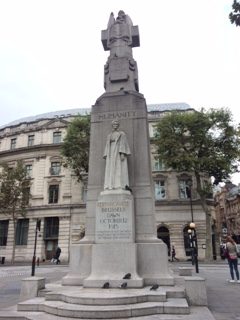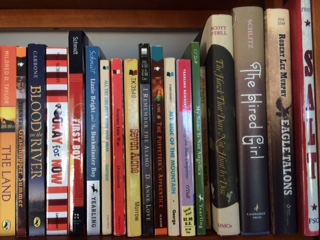Next month we’ll remember the 100th anniversary of the end of The Great War/The War to End All Wars/World War I.
The war began in Europe in 1914, the United States joined the fighting in 1917, and the Armistice ended the war at 11 a.m. on 11/11/1918.
World War I was hard for America, but it devastated Europe.

For more information about the war and ways to honor the anniversary of the Armistice:
The United States World War I Centennial Commission
The National World War I Museum and Memorial
I’ve compiled a list (not exhaustive) of children’s books about the WWI-era that I have read, or that have been recommended to me.
Picture Books
The Donkey of Gallipoli: A True Story of Courage in World War I by Mark Greenwood, illustrated by Frané Lessac (2008, Candlewick Press)–non-fiction–Jack Simpson, a young British man, joined the Australian Army Medical Corps and at the Battle of Gallipoli in Turkey, Jack finds a lost donkey who helps him bring wounded men to safety.
The Poppy Lady: Moina Belle Michael and Her Tribute to Veterans by Barbara Elizabeth Walsh, paintings by Layne Johnson (2012, Calkins Creek)–non-fiction–When the U.S. joined the Great War, Moina wanted to help the soldiers. She knitted socks, rolled bandages, delivered books, and hosted a gathering room for soldiers. But, she also wanted to keep their memory alive by wearing a poppy and encouraging others to do the same.
Christmas in the Trenches by John McCutcheon, illustrated by Henri Sørensen (2006, Peachtree)–fiction–Enemy British and German soldiers celebrate Christmas together in December 1914, the first Christmas of WWI.
Doing Her Bit: A Story About the Woman’s Land Army of America by Erin Hagar, illustrated by Jen Hill (2016, Charlesbridge)—fiction–This book focuses on the real Helen Stevens who becomes a farmerette in 1917 to help raise food during WWI.
Knit Your Bit: A World War I Story by Deborah Hopkinson, illustrated by Steven Guarnaccia (2013, G.P. Putnam’s Sons)—fiction—A young American boy learns how to knit and participates in a three-day knitting competition so he can contribute to the war effort.
And the Soldiers Sang by J. Patrick Lewis, illustrated by Gary Kelley (2011, The Creative Co.)—fiction—A young Welsh soldier experiences the Christmas Truce on the Western Front during the first Christmas of WWI.
Winnie: The True Story of the Bear Who Inspired Winnie-the Pooh by Sally M. Walker, illustrated by Jonathan D. Voss (2015, Henry Holt and Co.)–non-fiction–A Canadian veterinarian on his way to the Great War rescues a bear cub before he leaves Canada and takes care of it in England until he must leave for the battles in France.
Middle Grade
Epidemic! The 1918 Influenza Pandemic by Stephanie True Peters (2005, Benchmark Books)–non-fiction–This book tells about the influenza pandemic that killed millions of people, how the pandemic was both spread and overshadowed by the Great War, and how scientists were able to study the influenza virus in the last part of the 20th Century.
Eyewitness: World War I by Simon Adams, photographs by Andy Crawford (2014, DK Publishing)–non-fiction–This book give an overview of the war by using lots of photographs from the war, as well as photographs of people and equipment from the war.
The Harlem Hellfighters: When Pride Met Courage by Walter Dean Myers and Bill Miles (2006, Amistad Publishing/HarperCollins)–non-fiction–The authors briefly recount the history of African Americans in the American military from the time of the French and Indian War through World War I. But Myers and Miles focus on the formation of the 369th Infantry Regiment about the time the U.S. entered WWI, as well as the 369th’s bravery in combat in France.
Five Children on the Western Front by Kate Saunders (2014, Faber and Faber)—fiction—A continuation of E. Nesbit’s Five Children and It books when the Psammead—a sand fairy—turns up in the British Pemberton children’s gravel pit again right before the oldest boy is sent to the war in France. As the war continues, the other older Pemberton children grow up, one becomes a volunteer nurse, and another becomes a soldier. Meanwhile, the Psammead deals with his past sins.
Moon Over Manifest by Clare Vanderpool (2010, Delacorte Press)—fiction–In 1936, 12-year-old Abilene is sent to Manifest, Kansas, where she learns what happened to the people of Manifest during WWI.
Remember the Lusitania! by Diana Preston (2003, Walker Publishing)—non-fiction—Eyewitness accounts of the last voyage of the Lusitania, the British passenger ocean liner torpedoed by a German u-boat in 1915.
The Silver Pony by Sonya Hartnett, illustrated by Don Powers (first published in 2014, by Penguin, Australia)—fiction—Two French girls, Marcelle and Coco find an English soldier hiding in the woods. As they help him survive and return home to his sick brother, he tells them stories connected to the silver pony figurine his brother gave him to help him “do his best.”
Stubby the War Dog: the True Story of World War I’s Bravest Dog by Ann Bausum (2014, National Geographic)—non-fiction—Stubby, a stray dog, adopts some U.S. soldiers, accompanies them to the trenches in France, saves their lives, and comes home a hero.
Treaties, Trenches, Mud, and Blood (Nathan Hale’s Hazardous Tales) written and illustrated by Nathan Hale (2014, Amulet Books)—graphic novel—Hale gives an overview of the causes, countries involved, battles, and results of WWI.
The Usborne Introduction to the First World War by Ruth Brocklehurst & Henry Brook—non-fiction–(2007, Usborne Publishing)–This book gives an in-depth look at various aspects of the war, as well as internet links for more information.
War Horse by Michael Morpurgo (1982, Kaye & Ward)—fiction–Joey, a British horse, is sold away from his beloved Albert and sent to the battlefields of WWI.
Young Adult
Crossing Stones by Helen Frost (2009, Frances Foster Books)—verse novel–During WWI, four teens deal with women’s rights, dissent, the home front, the influenza epidemic, and the faraway battles.
Hattie Big Sky by Kirby Larson (2006, Delacorte Press)—fiction–In 1917, 16-year-old Hattie moves from Iowa to the Montana homestead she inherited from her uncle. But the faraway war brings trouble even to rural Montana.
Rilla of Ingleside by Lucy Maud Montgomery (1921, McClelland & Stewart)—fiction–Anne (of Green Gables-fame) is grown up, and her children come of age during The Great War. Two of her sons join the Canadian military, but Anne’s youngest child, Rilla, contributes on the homefront, including taking care of an orphaned infant.
The War to End All Wars: World War I by Russell Freedman (2010, Clarion Books)—non-fiction—A thorough look at the causes, the nations, the battles, the technology, the people, and the effects of WWI.
Women Heroes of World War I: 16 Remarkable Resisters, Soldiers, Spies, and Medics (Women of Action) by Kathryn J. Atwood (2014, Chicago Review Press)—non-fiction—This book features biographies of 16 women who risked their lives–and some died–doing what they could to save lives, fight (literally) for their allies, and inform the public.
What children’s books about, or set during, the WWI era would you recommend for my list? Why?

